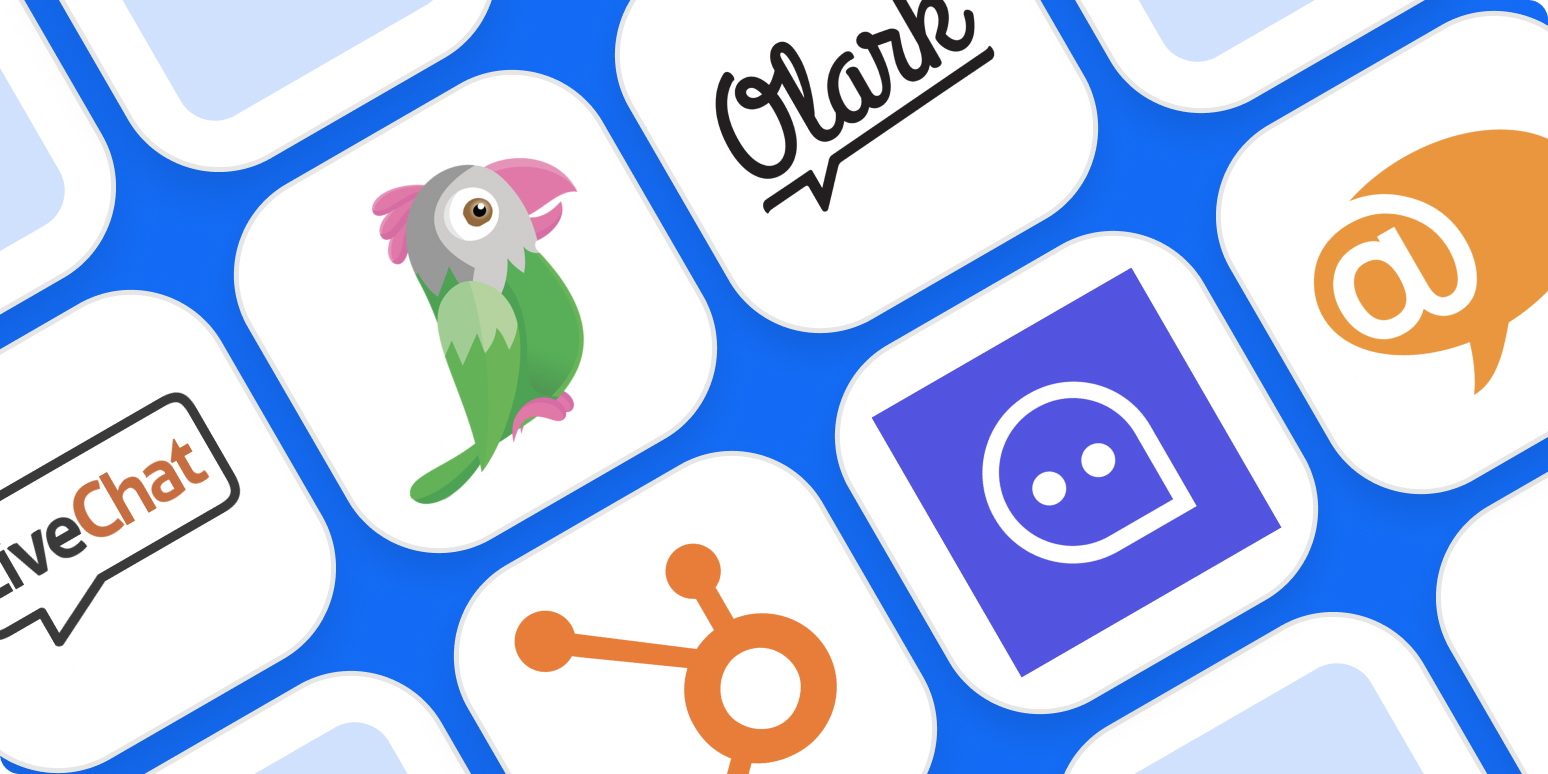A customer-centric strategy touches all parts of your business, but you can improve your customer service almost instantly—and at very little cost—with live chat. Live chat is the preferred customer channel for handling service issues, and it produces one of the highest satisfaction rates of any channel. It’s also a relatively affordable app to add to your existing technology stack.
But because there are so many choices for live chat apps, it’s hard to know where to start. To help you navigate, we’ve done some of the heavy lifting. We researched and evaluated over 30 live chat apps for customer support, and we thoroughly tested the most promising. From there, we selected the nine best live chat apps—from free to full-featured, with some special ones in between.
The 9 best live chat apps for customer support in 2021
-
LiveChat for overall ease of use and functionality
-
tawk.to for a free, full-featured live chat app
-
Smartsupp for understanding how visitors are engaging with your website
-
LiveHelpNow for tracking customer satisfaction
-
Olark for a la carte pricing options
-
Zendesk Support for a full-featured service suite
-
HubSpot for free live chat integrated with a free CRM
-
Chatlio for Slack power users
-
LiveAgent for agent gamification
What makes a great live chat customer support app?
How we evaluate and test apps
All of our best apps roundups are written by humans who’ve spent much of their careers using, testing, and writing about software. We spend dozens of hours researching and testing apps, using each app as it’s intended to be used and evaluating it against the criteria we set for the category. We’re never paid for placement in our articles from any app or for links to any site—we value the trust readers put in us to offer authentic evaluations of the categories and apps we review. For more details on our process, read the full rundown of how we select apps to feature on the Zapier blog.
For consistency, we evaluated each platform using the same five criteria:
-
Affordability. Most of the apps on this list start at around $15/user/month and don’t go higher than $100 except in the case of enterprise plans. Some are even free.
-
Ease of setup and use. Live chat is designed to be user-friendly even if tech isn’t your thing. That said, some vendors make the user experience more enjoyable than others. We made sure, through our testing, that each of these apps was easy enough to deploy and use without feeling like you were learning a new language.
-
Management features. Yes, live chat can improve your customer service, but it’s still just a tool. To find success, you’ll need to monitor, measure, and improve your team’s chat performance. Some of the features that can help are staffing prediction, real-time activity reporting, chat monitoring, and automated chat routing. You’ll find a combination of these and other management-related tools in the apps we selected.
-
Advanced support options. To help make your service staff more efficient, we looked for apps with advanced support features. For example, having a knowledge base a few clicks away can help agents help customers solve their problems quickly without having to engage a more experienced teammate. Even better is a publicly-shared knowledge base, where customers can help themselves from a search of articles. Other features include ticket management, multi-channel chatting (e.g., SMS, social, video), bots, chat transfer, and automated messages.
-
Integration capabilities. We made sure that our selected live chat apps integrated natively or through Zapier with popular CRM, helpdesk, marketing, and eCommerce platforms.
Best customer support live chat app for overall ease of use and functionality
LiveChat (Web, Windows, Mac, iOS, Android)
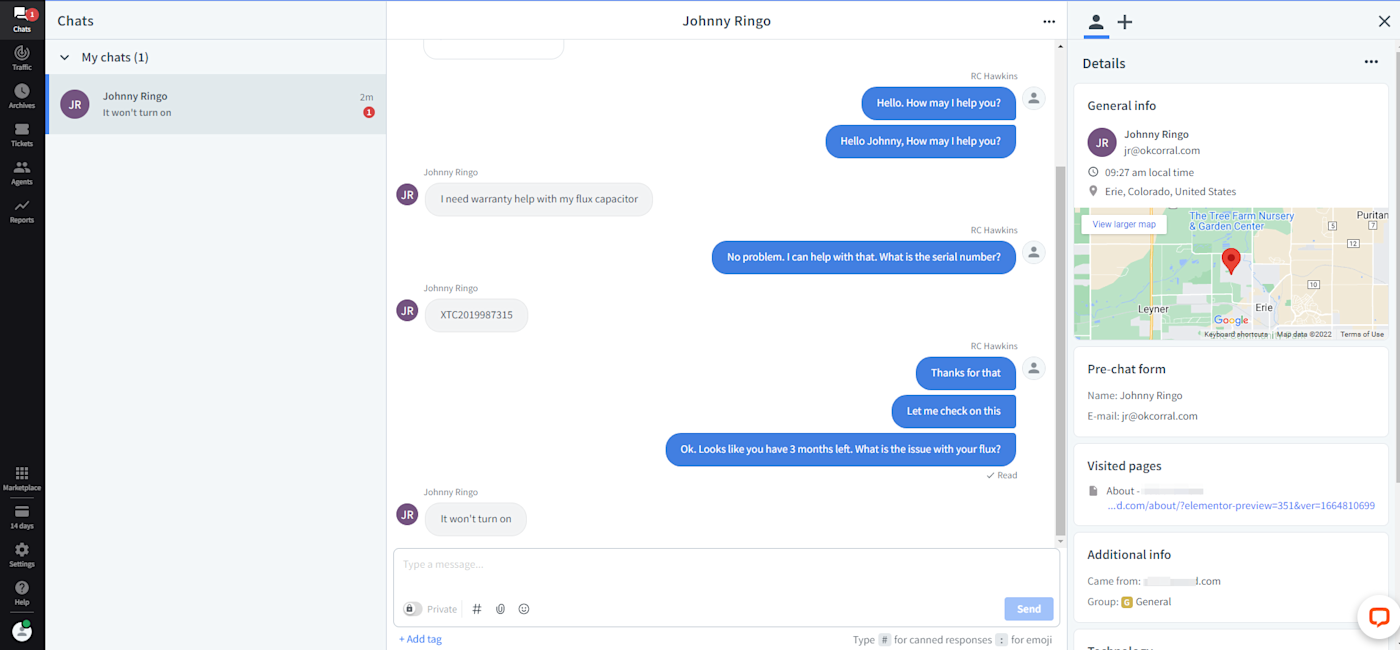
LiveChat is an app with plenty of support-focused features wrapped in an attractive UI that makes it a pleasure to use. For teams that need more than just chat and ticketing, the company also offers separate but integratable chatbot, help center, and knowledge base products.
The first thing you’ll notice is the clean and modern feel of the chat console. The core functions—chats, traffic, tickets, reports, settings, and help, among others—are labeled icons listed vertically on the left side of the screen. To begin, I installed the chat widget on my site using LiveChat’s WordPress plugin. It took just a few minutes. From there, clicking on the settings icon brings up everything you need to customize the widget and set up the other features.
Each setting includes a brief explanation of its purpose with intuitive, visual instructions for setup and activation. You’d be hard-pressed to get stuck setting up your chat, but if you do, each plan comes with 24x7x365 phone, email, and chat support, plus an extensive knowledge base. The times I’ve had to use their chat support, they were quick to respond and answer my questions.
Once you’re up and running, you’ll have all the major features you need: chat transfer, message sneak peek (see what a visitor is typing as they type), transcripts, and Messaging Mode. This feature lets you and your customers communicate by chat and email even when one or the other is not online. For example, a customer can send a chat even if it’s after business hours, and it will be waiting for you in the chat queue. When you do respond, it will go to both the customer’s chat widget and email.
For managers, intelligent chat routing distributes chats evenly to available agents, and the Supervision feature lets you train agents during live chats behind the scenes. To start Supervision, click on the agent conversation you want to interact with, select Supervise chat, then type a message. The agent you’re chatting with will see your message in their chat, but it won’t be visible to the customer.
One of the main menu items is Traffic, which shows a list of all visitors on your site. From here, you can proactively start a chat either with a pre-made greeting or by clicking on the pencil icon and typing a custom note. This list shows which customers are chatting, waiting for a reply, supervised, or just browsing. Click on any name or IP address in the queue and you’ll see detailed info such as location, visited pages, and the cumulative number of visits and chats.
The dashboard shows the most important real-time metrics for the day, such as ongoing chats, unassigned tickets, and logged-in agents. Clicking each will take you to the current, detailed view for each category. Reporting lets you track things such as greeting conversions, availability, ticket first-response time, and tracked sales from chats for eCommerce businesses.
You can connect LiveChat to thousands of other apps with LiveChat’s Zapier integrations, which lets you do things like automatically adding LiveChat contacts to HubSpot or tracking LiveChat conversations in Google Sheets.
LiveChat Price: From $16/month for one user
Best free, full-featured live chat app for customer support
tawk.to (Windows, Mac, iOS, Android)

Unlimited users. Automated triggers. Chat whisper. Knowledge base. These are some of the features in tawk.to’s free live chat app. Yes, free forever unless you want to add features such as video screen sharing ($29/month), hire a live agent to field your chats ($1/hour), or remove the branding ($19/month). Considering the features that come with the free version, tawk.to is a bargain—and likely to satisfy many small businesses.
Tawk.to’s chat widget is completely customizable, allowing you to set when and where it’s visible on your site and how notifications are delivered, with options for sound notification, message preview, and estimated wait time. There’s also a consent form option and a scheduler to enable and disable the chat widget online automatically.
Messages queue in the chat inbox from newest to oldest, showing both closed and open messages. Each message shows the visitor’s IP address, location, email, operating system, and when/if they last visited. From here, the agent can attach files, tag the chat, email a transcript, and convert the chat to a ticket.
One newer feature is the knowledge base, which lets you create a subdomain (e.g., zapier.tawk.to.help) to share help articles with customers and to use internally for agents. Customize it with your logo, colors, social sharing, and other elements to match your branding. Then choose a layout, add categories, and start loading articles. Your customers will then be able to find answers to their questions using the search box. And if they don’t find their answer, there’s a ticket submit link that will drop into your messaging inbox. Here you can assign it to a rep, add a priority, and respond with an email directly from the record.
Connect tawk.to the other apps in your tech stack with tawk.to’s Zapier integrations, which let you do things like send a message to Slack every time there’s a new chat in tawk.to or send all new tawk.to tickets to a task management app.
tawk.to Price: Free for unlimited users; paid add-ons (e.g., remove branding, screen share, audio/video calling) available.
Best customer support live chat app for understanding how visitors are engaging with your website
Smartsupp (Web, iOS, Android)
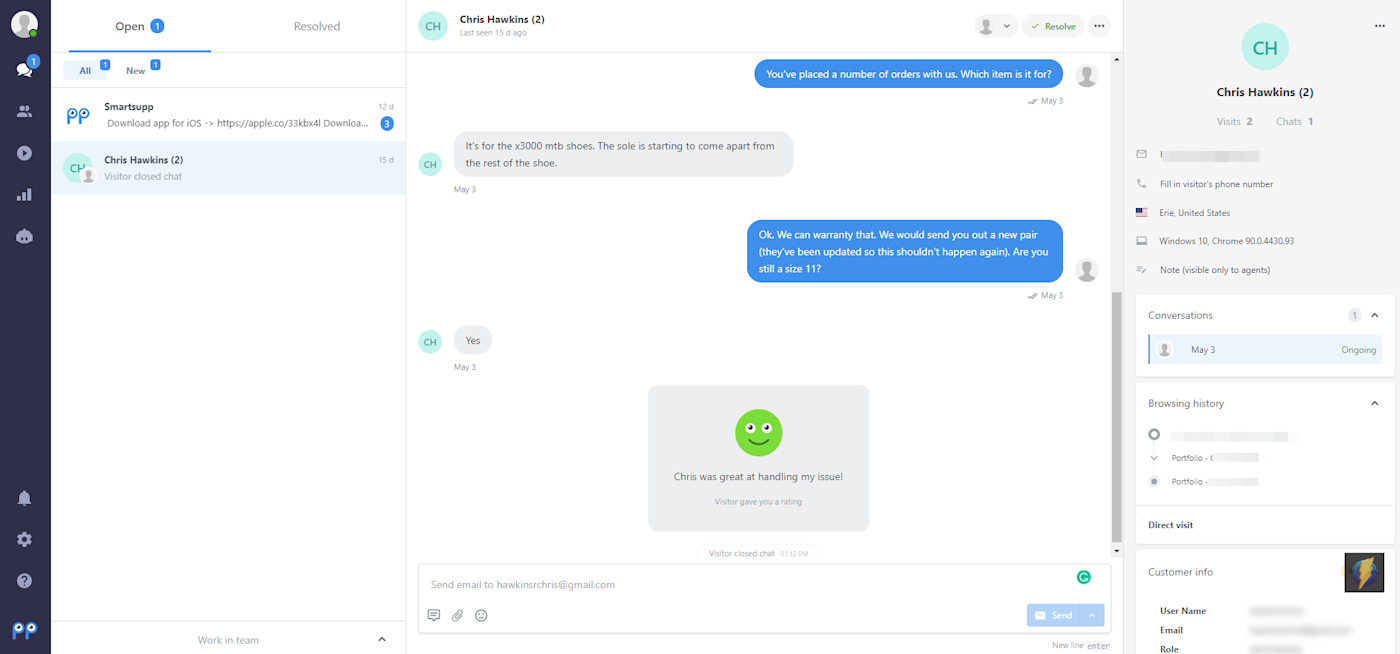
Want to understand how visitors are experiencing your website? The Smartsupp app combines live chat and video recordings similar to (though not as extensive as) what you find in behavior analytics tools like Hotjar and Mouseflow. From these videos, you’ll have a deeper understanding of how visitors are engaging—or not engaging—with your website.
To view recordings, click on the play button on the menu. Each is listed in order of visit, showing pages visited, time on site, and the referrer (e.g., direct visit). To find a specific visitor, click the filter button and search by pages visited, name, email, and other variables. Click on any listing to see the recordings in action. Visitor recordings show a visitor’s mouse movement, where they clicked, and any actions they took, such as filling out a form. In my test, it took just a few minutes for the recordings to show up from the site searches I performed.
Here are some possible applications. If you’re often receiving chat requests from the same product page of your site, review those chats and the behavior of each to see where visitors are getting stuck. Maybe it’s as simple as a broken link you were unaware of—unable to access that link, the visitor starts a chat to get a question answered. You can also see where visitors/customers are clicking the most on a page, how customers interact with pages before they convert (or abandon their cart), and more.
The included bots are another way to proactively serve customers without taking up an agent’s time. Smartsupp offers about a dozen pre-made bots covering a range of common sales and service topics. All of these can be further customized with conditions such as page URL and number of visits.
You can use Smartsupp’s native Google Analytics integration to do things like comparing the actions of chat visitors to all your site’s visitors for metrics like eCommerce conversion rates. In other words, how did the chat conversation affect sales? Integrations with a number of eCommerce platforms like BigCommerce, Shopify, and Magento make this even easier.
Smartsupp Price: Free (doesn’t include visitor recording) for 3 users; starting at $10/month for 3 users for plans with more features.
Best live chat app for tracking customer satisfaction
LiveHelpNow (Web, Mac, Windows, iOS, Android)

LiveHelpNow chat software makes gathering customer feedback easy with its customizable surveys. They also offer sentiment analysis to track chat conversations that are considered both negative and positive.
You can create unlimited surveys, adding custom colors and fonts, and using either a 5-star format or the 10-point Net Promoter Score (NPS), making it easy for the customer to answer quickly. You design the questions asked and deploy them post-chat in the chat window or via link in text, social media, or email. Then track the survey results in analytics by agent or company overall.
Sentiment analysis uses artificial intelligence to identify words and phrases from a chat, determining whether the conversation was negative or positive. If it detects a negative chat, it will automatically send an email to the admin so they can reach out to the agent, customer, or both to resolve a potentially poor experience. All chats are rated by sentiment analysis using a 10-point scale (10 being the highest) and then reported in the analytics section.
Another useful support feature is the automated idle chat messages. So if a visitor has not responded in, say, five minutes to an ongoing chat, a message will be sent to remind them that the agent is still there waiting to help. Similar messages can be sent to visitors when an agent hasn’t initially responded (e.g., “Very sorry for the delay. The next agent will be with you shortly”).
LiveHelpNow does more than sentiment analysis, though. Its Advertising Billboards feature lets you create up to 10 rotating messages within the chat window as either text messages or images with clickable links to send customers to your landing page. These messages are broadcast in the window during a chat for the customer to see. Advertise upcoming events, special operating hours, or anything else that may be of interest.
And the Chat Whisper feature lets managers monitor and coach their agents during chats. The manager selects an active chat session from their dashboard, then types a message into their own chat window in real-time. The manager’s name and message will appear in the agent’s window as a thread with the customer’s, but only the agent will see it. In turn, the agent can respond to the manager by clicking Respond.
If I had one suggestion for improvement, it would be to give the UI a facelift—it looks like it was designed when MySpace was hot. The icons, font, and layout all feel dated. For example, the agent’s small chat window is crammed on the left side, and while it can be expanded somewhat to the left, it’s still generally smaller than the others reviewed here. The good news is that a UI redesign is scheduled for later this year.
LiveHelpNow Price: From $21/month for one user; add-ons also available (Support Ticket, FAQ/Self Service, Call Management)
Best customer support live chat app for a la carte pricing options
Olark (Web, iOS, Android)
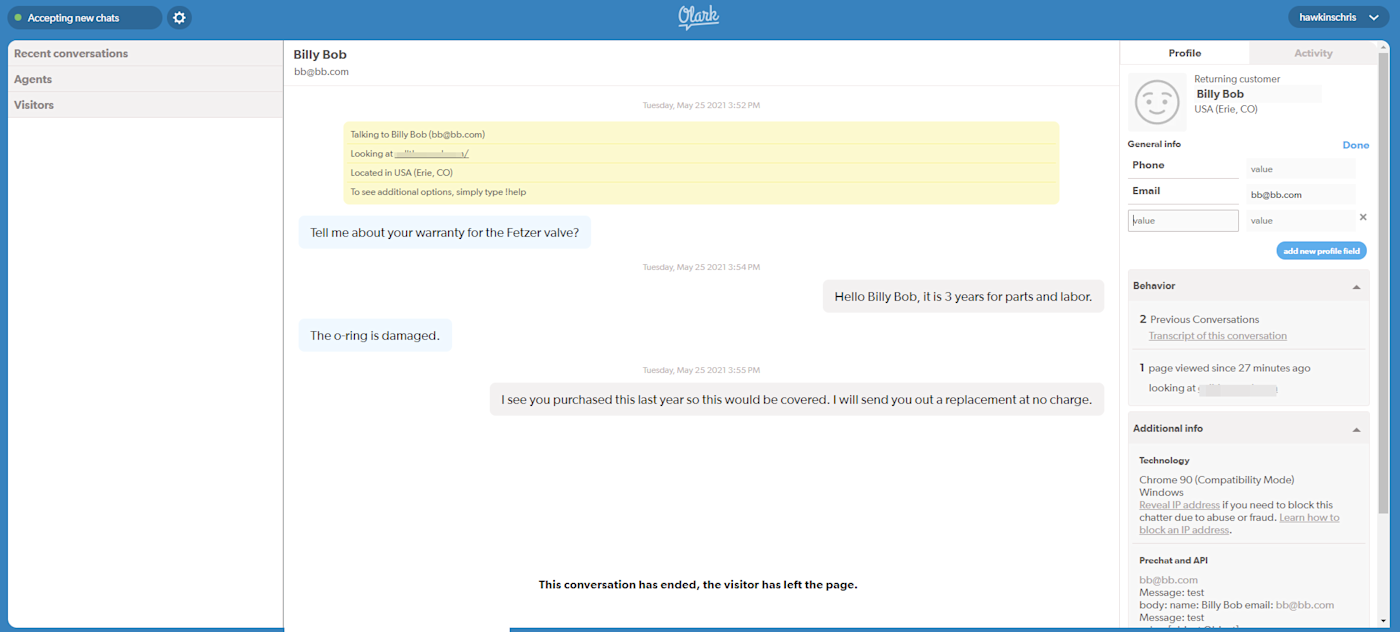
If your chat support team is relatively small and you’re looking for pricing flexibility, Olark is worth exploring. It’s inexpensive live chat software offering add-on options for specialty service and sales needs. Called Powerups, these add-ons include visitor co-browsing, visitor insights, translation, and a non-branded chat widget.
Olark’s base price ($15/user/month, billed annually) includes features such as unlimited chats, transcripts, automated messages, pre-chat forms, and reports. If you want to add a Powerup for live chat translation, for example, activate it in your account. Whether you have two or 10 users, you’ll only pay an additional $29/month. If you decide it’s not worth the investment, you can cancel the Powerup at any time.
Visitor co-browsing lets you see your visitor’s screen and take full control to help them locate items or complete tasks. It’s also the most expensive Powerup ($99/month), but it’s a feature that, if offered at all by other chat vendors, is only found in more expensive plans. Chat translation ($29/month) detects a visitor’s language from more than 100 languages and then translates agent and visitor chats in real-time.
Visitor insights ($59 and $99/month) provide data about a visitor—social profile links, company, job title, interests, and others—as long as you have an email, which you can acquire from a pre-chat survey. And if you’d like to remove “Powered by Olark” on the chatbox, $59/month will let you do that and add your own brand.
As for the app itself, the user interface is intuitively laid out with the main dashboard showing team metrics, transcripts, agent activity, and chat volume. Click Launch chat from here to open up the chat window, then click on the settings icon to adjust individual settings, such as chat alert sounds, showing commands and shortcuts as you type, and editing your display name and avatar. With a click, all of your commands such as transfer, trigger, and transcript are accessed within the chat typing box. And each visitor’s previous chat history and website activity are displayed in the profile column on the right.
Olark includes more than two dozen integrations for many popular CRMs, help desk, and eCommerce platforms. And testing the Olark waters is easy with their two-week free trial; you can also try a free plan with basic features and one user, capped at 20 chats/month. Finally, their Pro plan, targeted to larger businesses, offers everything in the regular plan plus a chatbot (“CoPilot”), live training, priority support, and a dedicated account manager. (You have to call for pricing on that one.)
You can connect Olark to thousands of other apps with Olark’s Zapier integrations, letting you do things like add chat participants to your email marketing list or sending new chat transcripts directly to Slack.
Olark Price: From $15/user/month; add-ons available a la carte from $29 to $99 per month.
Best live chat app with a full-featured service suite
Zendesk (Web, iOS, Android)
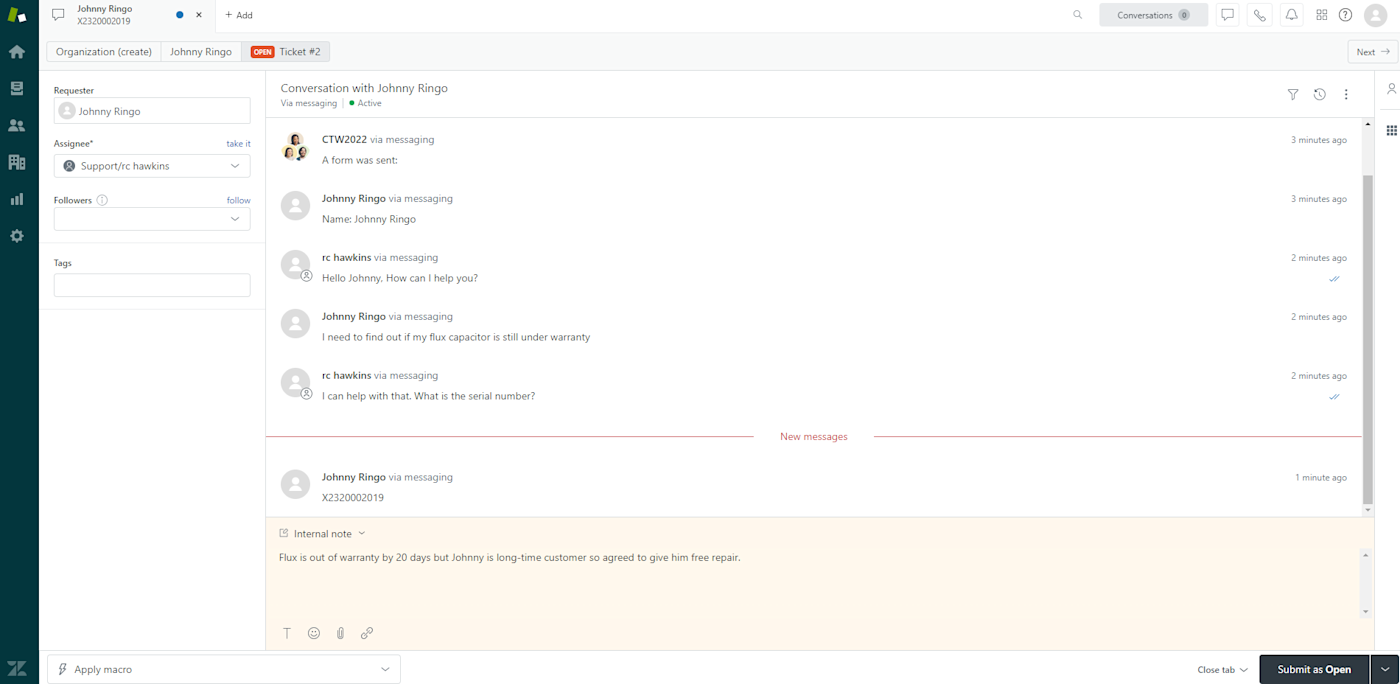
Though 14 years is a long time in this industry, it seems like Zendesk has been around much longer—it’s a name that has become ubiquitous in the support space. And it’s not hard to see why. The Zendesk service suite has everything you need to handle service duties, including chat, talk, social, and a help center—all packaged in a powerful platform that will take some getting used to.
As I’ve done with every app in this test, I started by downloading their WordPress plugin to make installation effortless—only it wasn’t without some effort. But after a chat with Zendesk support, a few deactivate/activate clicks, and a little salt over the shoulder, I was up and running. I don’t know why, but it just started to work. A more reliable solution would be to install the chat code in the body of your site’s HTML source code.
From the main support page, you’ll access all settings and channels. Click on any channel to open a separate window for that particular console. For Chat, you’ll be taken to the home screen showing real-time analytics for visitors and chats. Open the settings to access routing rules, triggers, and other features. With routing, you can set chat limits for certain agents and add skills for each agent, so they’ll only receive chats they’re qualified to handle.
While in a chat, an agent can submit a ticket, which will funnel to the support page as open, label it as pending customer response, or close it. Tag other agents or managers within the chat if you want to keep them informed of the ticket process. A timeline of all previous chats with a visitor are populated in the sidebar for reference, and you can hover over any interaction to see the full chat details.
With the Talk channel, you can purchase business numbers or bring over your existing numbers. You’ll pay a monthly line rental fee and fairly competitive per-minute pricing. From the talk console, create greetings and configure your IVR (phone tree) settings to determine how incoming calls are routed. Your lines will then be accessible from a customer’s record. For example, if you’re chatting and need to call your customer to resolve an issue, click the call icon in the chat window and dial the number. Each live call is shown and tracked in the talk console. Also displayed are various call metrics, such as average wait times and calls abandoned.
Two other main channels include the help center and community forum. Zendesk makes setting these up easy by providing an instantly accessible subdomain where you can begin building out your help FAQs, articles, and topics. You choose which articles are internally or publicly available and can allow for commenting and promotion (voting) before posting. In the forum, all posts will be sent to the content moderation queue for approval.
You can connect Zendesk to thousands of apps with Zendesk’s Zapier integrations to do things like automatically create tickets for new form entries, add new tickets to your project management tool, and more.
Zendesk price: From $49/month
Best free live chat app integrated with a free CRM
HubSpot (Web, iOS, Android)
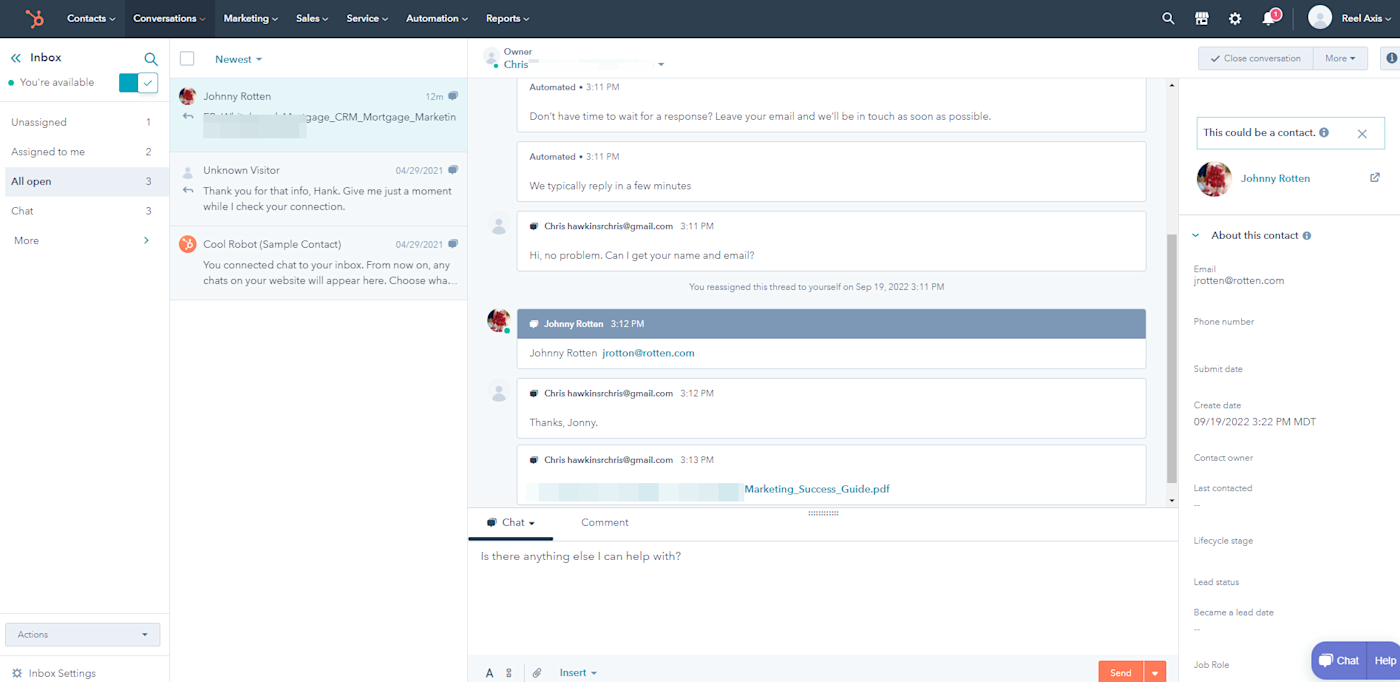
HubSpot’s chat feature included in their always-free CRM hasn’t changed much in the last few years. It’s still relatively basic compared to most other chat apps, but with HubSpot, you’re likely choosing to use their CRM first—the chat feature comes as a bonus. And being part of their ecosystem means easier integration with their other paid “hubs” such as marketing, sales, and the new operations software.
The chat widget can be customized with your company colors, agents’ pictures, greetings, and away messages. And because it’s integrated with the CRM, contacts are automatically created from a chat as long as an email address is provided. With HubSpot’s Zapier integrations, you can automate the process even more, sending those contacts to the other apps in your tech stack.
The chatflows feature lets you build chat messages to engage different types of visitors. For each chatflow you create, you can designate the sender, determine who will see the message (e.g., all visitors, segmented lists), and decide where on your site a visitor will see it. For example, you may want to send a proactive chat for a segment of customers who recently purchased and are visiting your help page.
If/then branching, which can help better identify support and sales inquiries to get them routed correctly, is now part of their paid service hubs. But they still offer free bots with pre-made and editable questions that most small businesses will find helpful, especially when they’re unable to field a chat. You can set filters for who receives the bot, on what page, and when (e.g., 50% of the page scrolled). HubSpot makes this process simple with its chatflow builder, providing clear explanations for each step and option. I spent about 10 minutes setting up the bot, then deployed and tested it. From there, I went back into the bot and tweaked a few of the questions to get the flow right and capture the info I wanted. All painless.
The live chat and chatbot setup are included in the CRM under the Conversations header. Also accessed here is the team inbox showing all chats, connected team user email accounts, and Facebook Messenger (if integrated) conversations. This is your central customer support inbox for communicating with visitors and customers. It’s also where an agent will select and engage in a chat conversation.
Once a chat visitor is created as a contact with an email, this contact record will be associated with them, whether they come back for another chat, fill out a website form, or send an email. All of these interactions will be recorded in their CRM record.
HubSpot Price: Free for unlimited users and a free forever CRM; marketing, sales, and service hubs start at $45/month per user if paid annually.
Best customer support live chat app for Slack power users
Chatlio (Web, Slack)

If you’re a Slack power user and want basic chat functionality built into the popular app, check out Chatlio. It lets agents chat directly from Slack, whereas typical third-party integrations only provide alerts for new chats, making agents open a separate chat app to respond.
The connection from Chatlio to Slack takes just a few clicks. You create a Slack channel for chats from the Chatlio web interface, customize the appearance of your chat widget, and then install the widget on your site. From there, you can fine-tune chat behavior with Slack. Determine what should happen when Chatlio is off, when there are no active Slack users in #livechat, or when all operators are busy. You can set which kind of chat notifications you want in Slack and the types of customer data you want displayed in the Slack message, such as name and email.
In Slack, agents can see chat visitor information for country, city, IP address, or personal details if it’s a returning customer. You can also attach images and files, and if you want to perform commands for Chatlio while in Slack, there are several dozen slash commands to control the behavior and configuration of Chatlio.
For example, if you wanted to require visitors to provide an email address before starting to chat, rather than go into the Chatlio interface to set this up, you could simply enter /chatlio require-info in your Slack chat channel. Saved replies let you create automated reply shortcuts to common questions. For questions about warranty info, you would add “warranty” to your reply’s trigger phrase and the appropriate weblink, so the next time a visitor types “warranty,” the link would automatically be sent. (You can also turn off automation and simply send a shortcut reply such as /chatlio reply warranty.)
Should you forget a command, just type /chatlio help, and all available commands will appear on screen. While you can’t control every Chatlio task in Slack, you can control over two dozen common functions without having to go into the Chatlio dashboard.
Other support-related features include auto-triggered messages, pre-chat surveys, chat transcripts, and the ability to deploy chat on multiple domains. Reporting is relatively basic, though, with chat activity summaries by team and agent, chat history, and average chat availability.
You can connect Chatlio to thousands of other apps with Chatlio’s Zapier integrations, which means you can do things like automatically create conversations in Help Scout based on new offline messages in Chatlio or send text messages when there are new conversations in Chatlio.
Chatlio Price: From $29/month for two users
Best live chat app for agent gamification
LiveAgent (Web, iOS, Android)
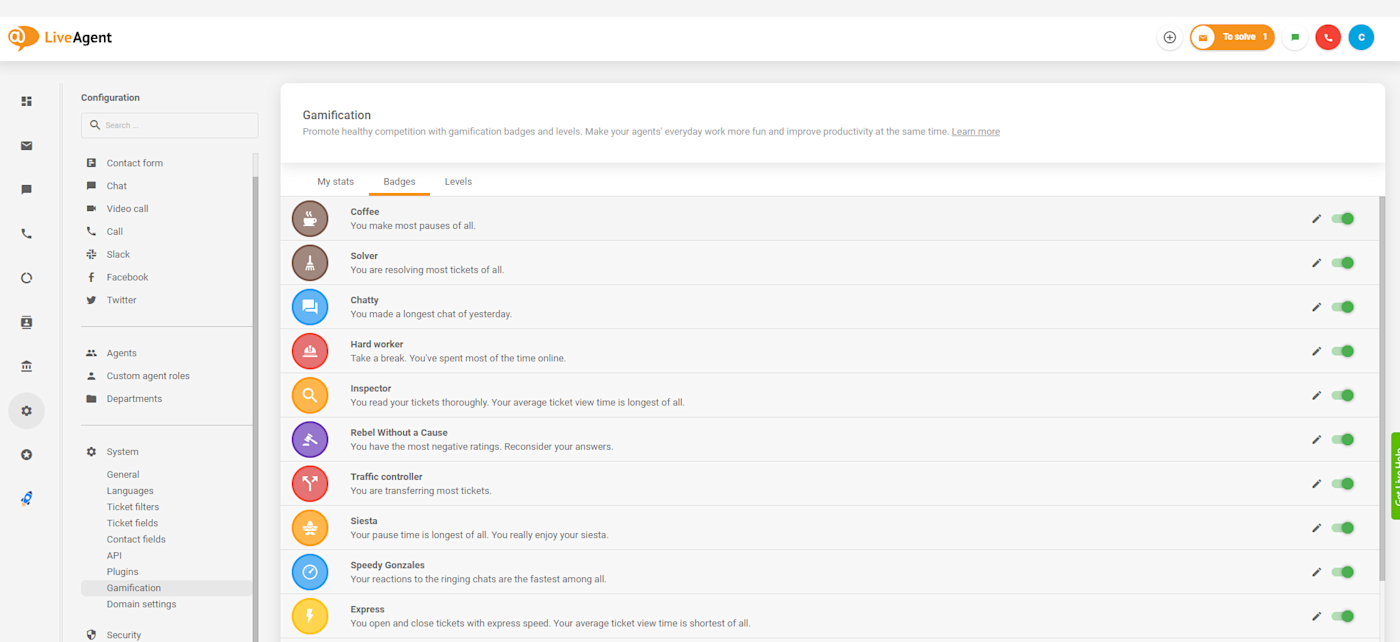
If you want to improve customer support and make your reps’ jobs more fun and competitive, LiveAgent’s gamification might be your answer. This feature lets agents monitor key support stats, earn badges, and progress through 12 support levels from Novice to King.
You can customize each support level based on conditions, such as chats per hour, answers per hour, missed chats, and several dozen others. Here’s a description for a Pro: You are a Pro now. Your answers are precise and to the point. Customers shiver with expectation waiting for your answers. Answer 500 tickets or make 500 chats to reach this level. In this description, you can edit both the number required and the condition. These levels are achieved over time and can’t be lost because of inactivity. Agents can also earn badges for things like the fastest chat response time, and each one is customizable.
Once you have these elements defined, you can start to track performance on the LiveAgent dashboard. Here you can see agent productivity and a leaderboard with filters for time period and by conditions such as positive ratings, work time, badges, and levels.
Gamification is just one of the many features to help support teams improve the customer experience—LiveAgent is a full customer support suite. Other standout features include a Twitter and Facebook integration for managing your company social channels, where agents can monitor mentions, respond to Tweets, and create support tickets right from the chat interface. There’s also a self-service customer support portal for managing forum posts, articles, and customer feedback.
You can also automate LiveAgent with LiveAgent’s Zapier integrations to do things like automatically send a Slack message whenever there’s a new LiveAgent customer or add new chat contacts to your email marketing list.
LiveAgent Price: From $15/user/month
The right live chat app can help improve your company’s customer support, giving both customers and potential customers the preferred channel to communicate. It’s also relatively inexpensive, easy to set up, and as simple to operate as an email inbox.
Looking for more full-featured customer support apps that include live chat? Head to our roundup of the best customer support apps, many of which also include live chat tools.
Originally written by Sean Kennedy, with contributions from Matthew Guay, this article was most recently updated in June 2021.
Need Any Technology Assistance? Call Pursho @ 0731-6725516

